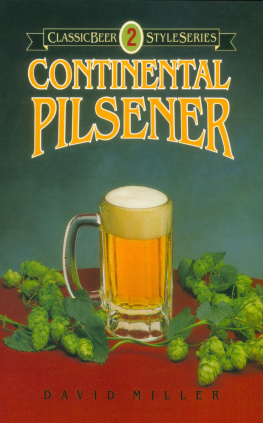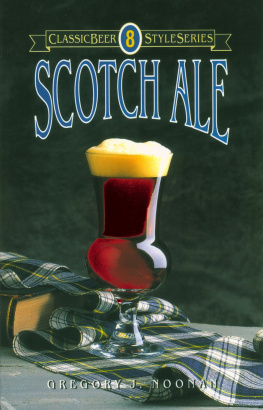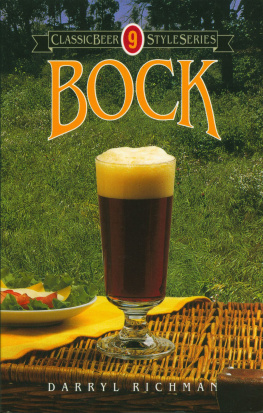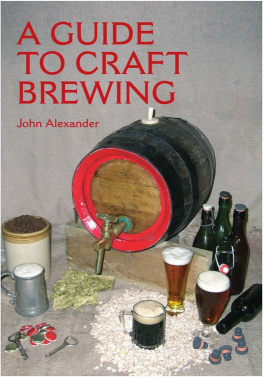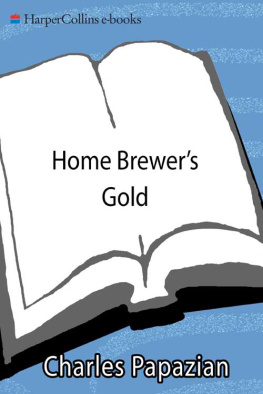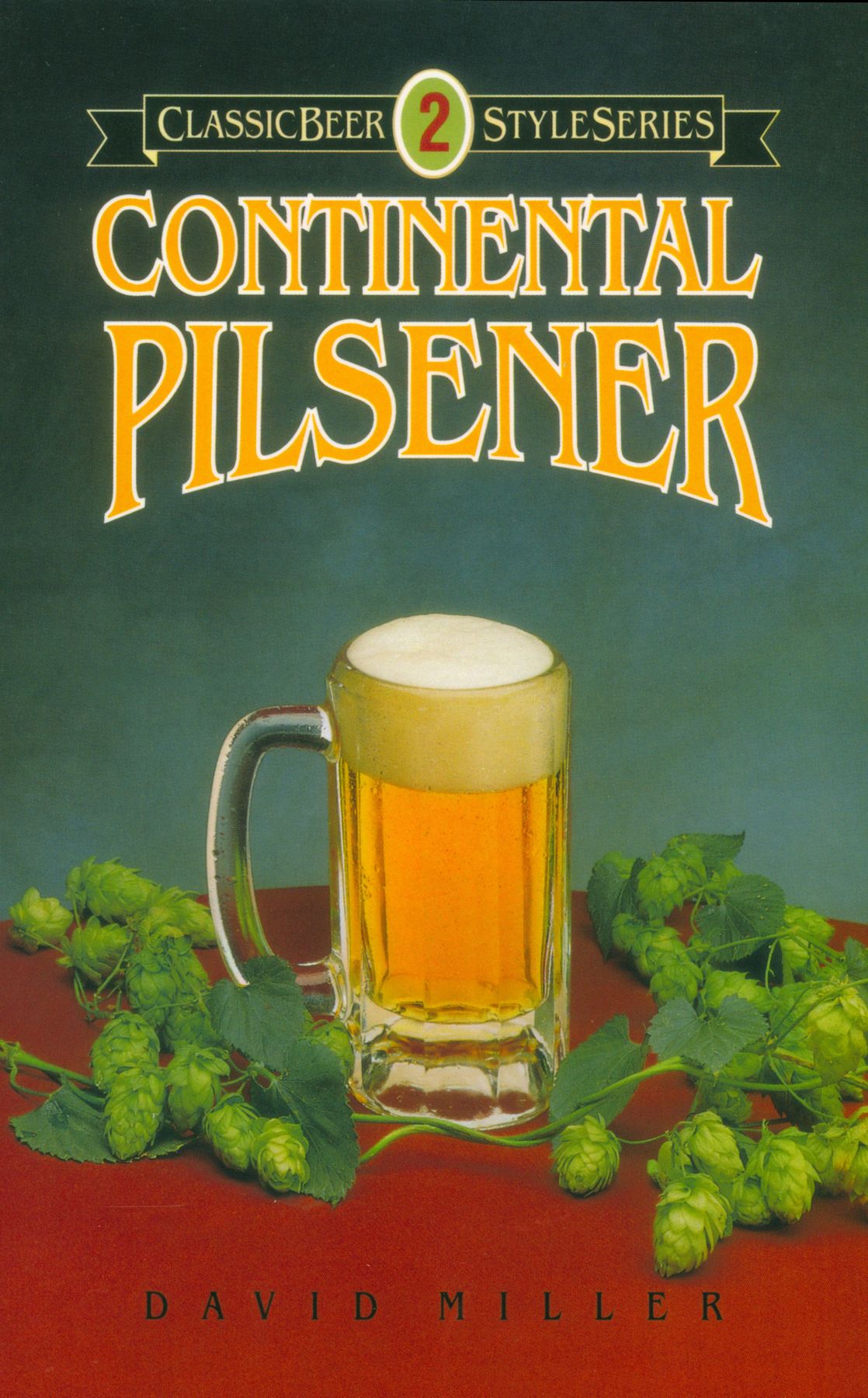
C LASSIC B EER S TYLE S ERIES
CONTINENTAL PILSENER
DAVID MILLER

brewers publications
Continental Pilsener
By Dave Miller
Classic Beer Style Series
Edited by Virginia Thomas
Copyright 1990 by Dave Miller
ISBN 978-0-937381-20-5
ISBN 978-1-938469-51-0 (eBook)
Published by Brewers Publications, a division of the Brewers Association
PO Box 1679, Boulder, Colorado 80306-1679 USA
Tel. (303) 447-0816 BrewersAssociation.org BrewersPublications.com
Direct all inquiries/orders to the above address.
All rights reserved. Except for use in a review, no portion of this book may be reproduced in any form without the express written permission of the publisher.
Neither the author, editor nor the publisher assumes any responsibility for the use or misuse of the information contained in this book.
Cover design by Robert L. Schram
Cover photography by Michael Lichter, Michael Lichter Photography
Table of Contents
I want first of all to thank Storey Communications, Inc., for granting permission to include in this book recipes from my Complete Handbook of Home Brewing.
I also want to thank Charlie Papazian for conceiving of the Classic Beer Style Series and asking me to participate in it. Over the last decade and a half, he has done more than anyone in this country to promote the appreciation of fine beer and encourage small-scale brewing.
I owe a special debt to all the authors listed in the bibliography, and the hundreds of brewmasters who stand behind them. Their work has made it possible for us to brew better beers today than ever before.
I also want to thank my wife and children for their patience with me during the writing of this book and their unfailing support of my brewing ambitions.
Finally, special thanks to George Fix for his many hours of generous assistance and good fellowship. I am proud to acknowledge my debt to his vast understanding of brewing science. Still, as fine a brewer as he is, he is a finer human being. This book is dedicated to him, with gratitude and admiration.
Brewers Publications would like to thank the following companies and individuals for letting us use their photographs:
- Michael Lichter,
- Phil Markowski,
- George Rivers,
- Charlie Papazian,
- Ian Priddey,
- Campaign for Real Ale (CAMRA),
Dave Miller is a native of St. Louis, Mo., where he still lives with his wife and children. He brewed his first batch of beer in 1975. In 1981 he won the title Hombrewer of the Year when his Dutch Pilsner was judged Best of Show at the American Homebrewers Assocation national competition. That same year, his first book, Home Brewing for Americans, was published. This was the first American book to deal with advanced all-grain brewing techniques.
Dave is a charter member of the St. Louis Brews homebrewing club and served for two years as its vice president, designing brewing projects, making presentations, and writing a monthly column for the club newsletter. He credits his club members with inspiring him to write The Complete Handbook of Home Brewing, which was published in November 1988. He has also written several articles for zymurgy magazine.
A former teacher, Dave has most recently been involved in lobbying the Missouri legislature for passage of a bill legalizing brewpubs. With the recent enactment of that measure, his current project is to found the first St. Louis brewpub and become its brewmaster.
Pilsener is the dominant beer style in the world today. From Milwaukee to Brussels and Juarez to Manila, beers brewed in every part of the planet proudly bear the label Pils or Pilsener, a tribute to the city of Plze, Czechoslovakia, where this style originated more than one hundred and fifty years ago. Many brand names also reflect the styles nation of origin: National Bohemian beer once was brewed in Pennsylvania, and today you can find on the shelves of American supermarkets Bohemia beer brewed in Mexico. To be sure, not all of these beers live up to their heritage. Many of those brewed in North America and the Orient are pallid imitations with only a superficial resemblance to the genuine Pils. Still, the very fact that so many brewers make a Pilsener-style product is testimony to the reputation of the Bohemian brewers and the impact their creation has had on the world of brewing.
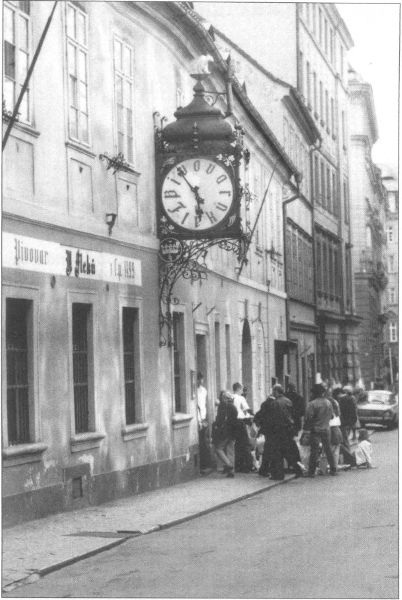
Pragues first and most famous tavern, U Fleck, dates back to 1499 and brews its own beer.
Probably the best evidence of Pilseners appeal has been its influence on the brewing industry of Munich, where lager brewing originated. Munichs proud tradition has been rooted in a very different style of beerdark, sweet, aromatic Mnchner. In the 1920s, when applied chemistry had advanced to the point where brewers could make both light-and dark-colored beers from the same water, the Munich brewers introduced a new style of Munich beer. The new beer was similar to the original but pale in color and obviously designed to compete with the Pilsener lagers that had gained so much popularity. Today this pale Mnchner, often called Helles, is the everyday drink of Bavarians. The Munich breweries also have started making their own Pilseners, and world beer authority Michael Jackson was bemused to find the great Spaten brewery touting its Pilsener as our best beer!
I first became acquainted with genuine, European Pilsener in Hamburg, Germany, in 1971. I went into a restaurant and a waiter, assuming that I was American and would want a light-colored beer, asked if I wanted Pilsener. Ja, I answered, not really sure what he meant or even why he was asking the question. Werent all beers Pilseners?
I dont believe I had ever tasted a European lager before, and that one was a revelation. Presented in the classic, tall, conical Pilsener glass, the beer had a depth of flavor I had never encountered. The stinging, flowery hop aroma was an enticing prelude to the rich, malty sweetness of the flavor, which was perfectly balanced by its bitterness. I drained the first one and ordered a second. Eighteen years later, I still credit that German Pilsener as the beginning of my serious involvement with the brewers art.
I still feel a special affection for a good Pilsener, and with the passage of time I appreciate its virtues even more. It is light without being insipid or bland; hoppy, yet smooth and mellow. It is simultaneously refreshing and immensely satisfyingtwo characteristics that may seem to be mutually exclusive and that are not, in my opinion, so successfully combined in any other beer style. At the same time, Pilsener is not a big or complex brew that brims with esters and other fermentation byproducts. It has a clean, simple flavor profile that makes it an ideal accompaniment for many types of food. It is a drink for all occasions, and I believe it is this adaptability that has made it the most popular beer today in the nations of Northern and Central Europe.
History
Since its beginnings in the mid-nineteenth century, the popularity and evolution of Pilsener have paralleled the technological developments of recent history. The world-wide popularity of lager beer in general, and Pilsener in particular would not have been possible without the development of transportation, refrigeration, and other basic industries. And while beer cannot be held accountable for the follies and triumphs of the modern world, it has contributed some of its minor advances.
Next page
